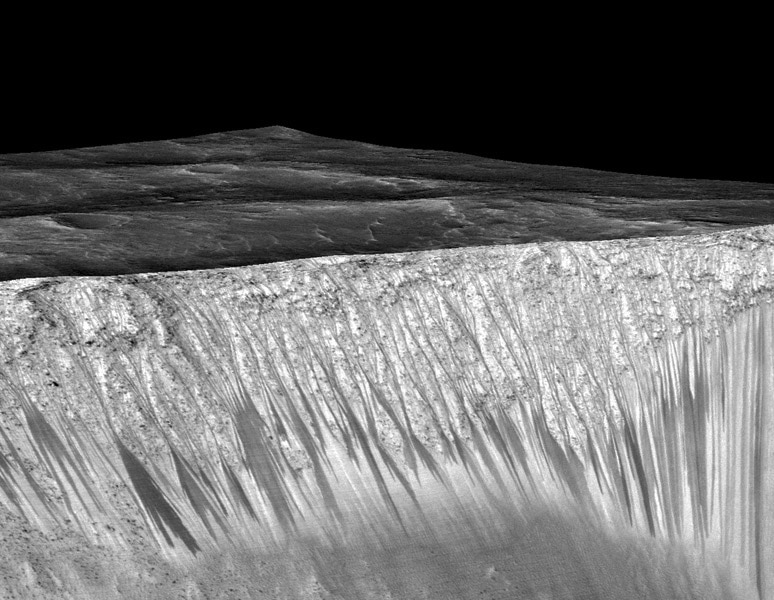Create a free profile to get unlimited access to exclusive videos, sweepstakes, and more!
The Big Mars News: Flowing Water on Mars, at Least Briefly

Scientists have found what they think is evidence of extant, if brief, flowing water on Mars.
In a NASA press conference on Monday, scientists claimed that images and spectra taken by the Mars Reconnaissance Orbiter’s HiRISE camera show what are called Recurrent Slope Lineae, or RSLs, straight dark streaks that run down the sides of craters and canyons on Mars. These features, which are a few meters across and hundreds of meters long, change with the seasons, becoming darker and more obvious in the spring and summer on the sides of crater walls facing the Sun. That strongly implies that warmth triggers the formation of the RSLs. The important finding: Scientists found evidence of salt deposits in these features, which in turn implies that briny, salty water is the force behind them. They think the darkening seen every spring is from water seepage!
If you want details, I wrote all about this Sunday in an article based on papers written by the scientists in question to be presented at a planetary science conference in Europe. I had not read the (embargoed) science papers, so what I wrote was based solely on those public papers, but it looks like I was right on the money.
Mind you, the detection of water here is indirect, through the dark streaks and the presence of salt. Still, the evidence they presented is very compelling, and their conclusions, in my opinion, likely to be correct. But there’s a problem, and it’s a big one: Where does the water come from?
We know there’s ice under the Martian surface. We see lots of evidence for it—it was seen directly by the Phoenix lander in 2008, and small asteroid impacts leave craters behind that excavate ice that can be seen. But Phoenix landed at high latitude, near the north pole where you’d expect ice, and the craters with ice only reach as far as midlatitude. But these RSLs are seen closer to the equator of Mars. Over time, the water ice there, to at least mild depths, should have disappeared, melting away.
Because of this, the authors of the work speculate that perhaps water is absorbed into the ground from the atmosphere, where it collects until there’s enough for it to flow—a process with the lovely name of deliquescence. The soil of Mars is loaded with a chemical called perchlorate, which is capable of absorbing water in this way, and perchlorates were found at the RSL sites.
So this idea ... holds water.
Still, the air on Mars is exceedingly thin, less than 1 percent of Earth’s. And there’s not much water in it, either, so it’s difficult to understand how enough water could collect to form these seepages. Although deliquescence is the preferred scenario by the scientists involved, they also admit the actual source of the water is still something of a mystery.
Opinion time: This is a wonderful discovery, and an important one. The origin of these features has been a mystery for a long time, and it does look like we’re finally starting to get a grip on it.
But it’s far from solved. Where does the water come from? How much is there? Is it just water, or are there other substances involved?
And what does this mean for the possibility for life on Mars? Well, in my opinion, it doesn’t change much. Not yet. We know Mars has lots of water ice, and it once had vast amounts of standing and flowing liquid water on its surface in the past. This doesn’t change that. Mars may once have had life, but we still don’t know, and don’t know if there’s life there now.
What it does change is the idea that there could be liquid water beneath the surface of Mars. This makes it less unlikely, I’d say, which I know sounds weak. But what we’ve seen here is temporary flowing water, not persistent liquid water. The bottom line is that we still don’t know if liquid water exists under the Martian surface or not.
But we’re learning. This is just one of many steps we’re taking in observing Mars. Remember, Mars is a planet, an entire world, with a rich history, diverse geography, and a lot of real estate. We’ve only just scratched the surface—in this case, almost literally—and there are great depths left to explore.














